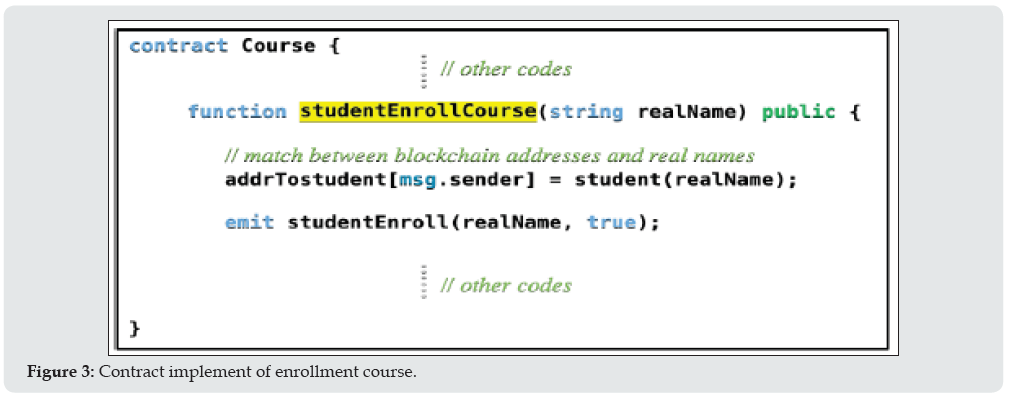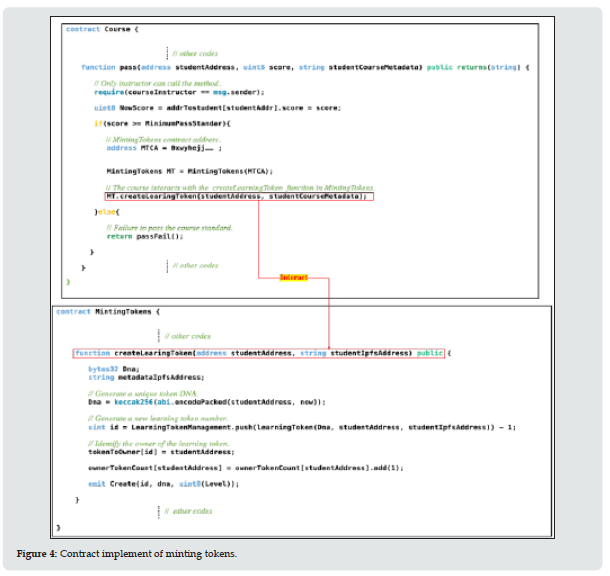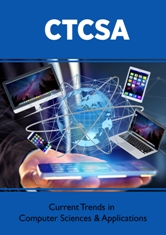
Lupine Publishers Group
Lupine Publishers
Menu
ISSN: 2643-6744
Research ArticleOpen Access
The Implementation of the Learning Token System for Open Educational Resources based-on Blockchain Smart Contracts Volume 2 - Issue 2
Hsien Sheng Hsiao1,2 and Wei Chen Liu1*
- 1Department of Technology Application and Human Resource Development, National Taiwan Normal University, Taiwan
- 2Institule for Research Excellence in Learning Sciences, National Taiwan Normal University, Taiwan
Received: December 01, 2022; Published: December 16, 2022
*Corresponding author:Kamaljeet Singh, UR Rao Satellite Centre, Old Airport Road, Bangalore India
DOI: 10.32474/CTCSA.2022.02.000133
Abstract
The COVID-19 pandemic has accelerated the digitization of education. Educators in different educational institutions began searching diverse online learning methods and tools in present materials, ensuring the quality of student learning. Open Educational Resources (OER) have been one of the significant trends of online learning platforms. During the pandemic, OER educators tried to reduce or eliminate tuition fees to raise students’ motivation of learning; however, it found that learners’ course completion rates turned lower than before as well as the instructor never updated the course and responded to student questions after the course was released. Recently, researchers have been searching for different ways to raise students learning motivation effectively, gamification is one of the popular methods. In this paper, the learning token system for OER was implemented by compiling block chain smart contracts, tokenizing the learners’ learning experience after completing the course into learning Non-Fungible Token (L-NFT), and using gamification elements such as learning tokens and social platforms to promote motivational effects.
Keywords: Gamification; Digital Badges; BlockChain Smart Contract; Learning Non Fungible Token (L-NFT)
Introduction
The COVID-19 pandemic has changed people’s lifestyles and learning channels. Many courses were forced to change to online in the middle of the semester. This worldwide change has had a huge impact on universities [1] and colleges [2]. Educational institutions were beginning to think about which online learning platforms and tools should be used to present materials to ensure the quality of student learning. Open Educational Resources (OER), such as Massive Open Online Course (MOOCs) have become an important solution in the epidemic [3-5]. Since the pandemic in March 2020, there has been a significant increase in the number of free course enrolments [6]. Many OER educators were responding to the crisis by reducing or eliminating tuition for thousands of courses. However, learners tend to have much lower completion rates in digital courses than in traditional physical classes [7], as well as instructor never updated the course and responded to student questions after the course was released. Recently, researchers have been looking for different ways to effectively increase students’ learning motivation, and gamification is one of the popular methods. In past research, digital badges allowed learners’ achievements in different e-learning platforms to be presented visually and embedded with uniform metadata to reflect individual abilities. Digital badges have gained increasing recognition as innovative tools for improving learning outcomes in higher education through the integration of gamification elements into teaching and learning [8,9]. For instance, [10] investigated learners’ motivation and learning attitudes using digital badges in college composition courses. The results showed that for learners with higher goals, digital badges were effective in improving their motivation.
Furthermore, in terms of academic performance, [11] experimented on technology competency and academic performance in college technology courses and found that badges led to increases in both learners’ confidence in using technology and overall course performance. Even though Digital badges are becoming increasingly popular, there are still not fully accepted as valid credentials and reflect accurately student achievement. In addition, its metadata is at risk of being tampered with. Therefore, this study uses blockchain technology for implementing a learning token system for OER by compiling smart contracts on the blockchain. The learning tokens of the proposed system are implemented using the ERC- 721 contract standard introduced by the Ethereum blockchain in 2017 and are unique in their characteristics and cannot be split or merged [12], hence the learning token of the proposed system is also known as Learning Non-Fungible Token (L-NFT). The purpose of tokenizing the learning experience is exploring export the learning tokens of learners after completing the course on social media. Through sharing and comparing with others, learners understand their shortcomings and set corresponding learning goals, determine which tokens are appropriate to obtain, and improve motivation for learning. Learners can also store token metadata acquired from different learning platforms or institutions on the blockchain using a uniform and unique format to ensure data integrity and security. In the future, authorized verifiers will be able to trace back to the original course for information such as the course’s grading criteria, and understand the quality of the tokens received, which will accurately reflect a person’s true ability.
System Structure
This research uses the Ethereum blockchain [13] to build a consortium blockchain and compile smart contracts using the solidity programming language. Each learner in the proposed system possesses a learning token wallet, they can earn the learning tokens when completing the courses. The verification node in the consortium blockchain is expected to be implemented by authorized institutions and set up by various educational institutions, such as learning platforms or universities. All participants interact with a smart contract on the blockchain, and the interaction is recorded on the blockchain. In addition, users are restricted to access only their learning data on the blockchain through access controls. In particular, the execution records generated from the execution of smart contracts are only available for users to view or share on social media. However, the learner’s data can be accessed by other users through authorization. In the following, we explain the architecture of the proposed system from the perspective of instructors, students, and authorized persons, as shown in Figure 1.
Instructor
After entering the system, the learning token wallet will automatically create an address and private key inside the wallet, then the instructor can use this private key to deploy the course. Then the instructor can input course information such as Course Title, Location, etc., and uploading them to the Interplanetary File system (IPFS), which is decentralized storage space. After uploading, an IPFS Hash value will be returned and stored on the blockchain. This approach can greatly improve the performance of the system and reduce the gas cost of transactions [14]. The instructor is authorized to view enrolled students’ learning tokens to design customized educational materials. And for those who pass the minimum standard, the instructor can call the token minting method in the course contract for them to mint tokens. The result of the casting, such as the learner’s name, location of study, and other metadata is stored in IPFS and returned as a Hash value which is recorded in the blockchain.
Student
After entering the system, a learning token wallet is automatically created with an address and private key inside the wallet. The student will use this private key to enroll in the courses of interest on the homepage. Instructors’ learning tokens can be viewed as a basis for course selection. And for those who pass the minimum standard, the instructor can call the token minting method in the course contract for them to mint tokens. The result of the casting is stored in IPFS and returned as a Hash value, which is recorded in the blockchain. Finally, student’s learning tokens can be shared on social media to further enhance learning motivation.
Authorized Person
Once an organization such as a company or school receives an authorization letter from an applicant, they can verify the learner information to the blockchain through the QR-code. Namely, the person who gets the blockchain address (or public key) can be authorized.
Smart Contract Implement
All participants in the proposed system are primarily interacting with the smart contracts on the blockchain. In order to make the proposed system work properly, three smart contracts, namely Course Fectory, Course and Minting Tokens, have be deployed. The section explains the code and interactions between contracts in three different situations.
The instructor creates a course
After entering the course information, the instructor creates the course. When the instructor sends the course information, which triggers the red block to generate a new course contract, as shown in Figure 2.
Students enroll a course
The student sends a transaction to the course contract that triggers the yellow block, as shown in Figure 3.
Students pass the course standards and Cast learning tokens
Learners with scores greater than the minimum pass criteria will trigger red block and interact with the minting contract to generate a unique learning token, as shown in Figure 4.
Conclusions and Discussion
This paper uses blockchain technology and smart contracts to construct a learning token system for OER that tokenizes the learning experiences earned from students’ course completion and puts them into their personal learning token wallets. It is expected that the collection of tokens and social media sharing will increase the motivation and attendance rate, as well as the motivation of instructors to update their courses. It also addresses the issues raised in the past literature on blockchain and education [15]. Giving students full control of their learning experience data, making it easy to access and share, increasing system security and transparency, simplifying the process of validation, and increasing opportunities for learners to cooperation with companies. In addition, the proposed system can provide a tool for the researchers in the field of education to conduct experiments on the learning motivation of future learners.
Acknowledgments
This work was financially supported by the “Institute for Research Excellence in Learning Sciences” and “Chinese Language and Technology Center” of National Taiwan Normal University (NTNU) from The Featured Areas Research Center Program within the framework of the Higher Education Sprout Project by the Ministry of Education (MOE) in Taiwan, and sponsored by the Ministry of Science and Technology, Taiwan, R.O.C. under Grant no. MOST 107-2511-H-003 -046 -MY3, 109-2511-H-003 -048 -MY2, 109-2622H-003-004, 110-2511-H-003 -023 -MY3, 110-2622-H- 003 -009.
References
- Russell MV, Simon JR, Helen C, Jessica P, Joseph W, et al. (2020) School closure and management practices during coronavirus outbreaks including COVID-19: A rapid systematic review. The Lancet Child & Adolescent Health 4(5): 397-404.
- Crawford J, Butler-Henderson K, Rudolph J, Malkawi B, Glowatz M, et al. (2020) COVID-19: 20 countries higher education intra-period digital pedagogy Journal of Applied Learning & Teaching 3(1): 9-28.
- Singh M, Adebayo SO, Saini M, Singh J (2021) Indian government E-learning initiatives in response to COVID-19 crisis: A case study on online learning in Indian higher education Education and Information Technologies 26: 7569-7607.
- David K (2020) Utilizing Open Education Resources to Enhance Students’ Learning Outcomes during the COVID-19 Schools Lockdown: A Case of Using Kolibri by Selected Government Schools in Journal of Learning for Development 7(3): 447- 458.
- Kanoksilapatham B (2021) OER as Language Online Lessons to Enhance Thai University Students’ English Language Skills in the COVID-19 Pandemic Southeast Asian Journal of English Language Studies 27(2): 130-143.
- Impey C, Formanek M (2021) MOOCS and 100 Days of COVID: Enrollment surges in massive open online astronomy classes during the coronavirus Social Sciences & Humanities Open 4(1): 100-177.
- Evans BJ, Baker RB, Dee TS (2016) Persistence Patterns in Massive Open Online Courses (MOOCs). The Journal of Higher Education 87(2): 206-242.
- Davies R, Randall D, West, Richard E (2015) Using Open Badges to Certify Practicing Evaluators. American Journal of Evaluation 36(2): 151-163.
- Wallis P, Martinez MS (2013) Motivating skill-based promotion with In Proceedings of the 41st annual ACM SIGUCCS conference on User services pp. 175-180.
- Reid A J, Paster D, Abramovich S (2015) Digital badges in undergraduate composition courses: Effects on intrinsic Journal of Computers in Education 2(4): 377-398.
- Newby TJ, Cheng Z (2020) Instructional digital badges: Effective learning Educational Technology Research and Development 68(3): 1053-1067.
- Entriken WD Shirley, J Evans, N Sachs (2018) ERC-721 Non-Fungible Token Standard.
- Buterin V (2014) A next-generation smart contract and decentralized application White paper 3(37): 1-36.
- Poornima Devi P, Bragadeesh SA, Umamakeswari A (2021) Secure Data Management Using IPFS and Ethereum. Proceedings of International Conference on Computational Intelligence Data Science and Cloud Computing, Springer, Singapore, 565-578.
- Turkanović M, Hölbl M, Košič K, Heričko M, Kamišalić A et al. (2018) EduCTX: A Blockchain-Based Higher Education Credit Platform IEEE Access 6: 5112-5127.

Top Editors
-

Mark E Smith
Bio chemistry
University of Texas Medical Branch, USA -

Lawrence A Presley
Department of Criminal Justice
Liberty University, USA -

Thomas W Miller
Department of Psychiatry
University of Kentucky, USA -

Gjumrakch Aliev
Department of Medicine
Gally International Biomedical Research & Consulting LLC, USA -

Christopher Bryant
Department of Urbanisation and Agricultural
Montreal university, USA -

Robert William Frare
Oral & Maxillofacial Pathology
New York University, USA -

Rudolph Modesto Navari
Gastroenterology and Hepatology
University of Alabama, UK -

Andrew Hague
Department of Medicine
Universities of Bradford, UK -

George Gregory Buttigieg
Maltese College of Obstetrics and Gynaecology, Europe -

Chen-Hsiung Yeh
Oncology
Circulogene Theranostics, England -
.png)
Emilio Bucio-Carrillo
Radiation Chemistry
National University of Mexico, USA -
.jpg)
Casey J Grenier
Analytical Chemistry
Wentworth Institute of Technology, USA -
Hany Atalah
Minimally Invasive Surgery
Mercer University school of Medicine, USA -

Abu-Hussein Muhamad
Pediatric Dentistry
University of Athens , Greece

The annual scholar awards from Lupine Publishers honor a selected number Read More...








